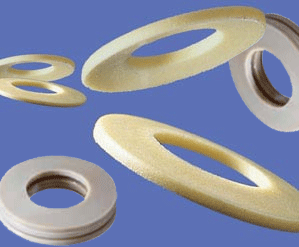- europages
- >
- IGUS® GMBH
- >
- Polysorb Disk springs made of plastics Polysorb Disk springs delivery program
Polysorb Disk springs made of plastics Polysorb Disk springs delivery program

Description
Polysorb Disk springs delivery program De [mm]: Di [mm]: disc springs are annulus discs stressable in the axial direction, which are turned over in the shape of a disc in the axial direction. disc springs provide a more favorable space usage than other spring types. They are particularly suitable for designs that demand a small spring deflection. + When not to use Polysorb Disk springs? For the implementation of specially flat load deflection curves that are possible with metal only with considerable complexity and expenditure (slotted versions). For compensation of axial clearance and manufacturing tolerances For vibration compensation For noise dampening When an antimagnetic material is required For electrical and thermal insulation When no corrosion problems should arise When lubrication is not necessary For low weight For low space requirement – When not to use polyserb disk springs? When constant spring forces are necessary over a wide temperature range When high spring forces are required The spring deflection of the disk spring is relatively small. Therefore a number of disk springs are combined in practice. Alternatively layered disk springs enhance the spring deflection in proportion to the number, whereby the overall spring force is as large as the force of the individual disk spring. To increase the force, the disk springs can be layered in parallel as a spring packet. Chemical resistance Polysorb disk springs are resistant to many chemicals. iglidur® A500 has a higher resistance than iglidur® J. Medium Resistance iglidur® J iglidur® A500 Alcohols + + Hydrocarbons + + Fats, oils without additives + + Fuels + + Diluted acids 0 to - + Strong acids - + Diluted bases + + Strong bases + to 0 + Humidity absorption The low humidity absorption allows them to be used in wet or humid environment. Polysorb® disk springs absorb humidity. Thereby their mechanical properties alter. In the worst application that can be thought of - extremely long application in water - Polysorb® disk springs still exhibit high spring force. iglidur® Standard environment saturated in water J 18 15 A500 24 23 Increased operating temperature Increased temperatures lead to the decline of stiffening in polymers. Polysorb® disk springs exhibit a maximum spring force of 8 N even at the maximum permitted temperature of 80° C. See figure for relationship of spring force to ambient temperature. Polysorb Disk springs long-term tests X = downward deflection [%] Y= spring force [N] A = JTEM-10 B = A500TEM-10 Figure 35.1: Spring force depending on the percentage of deflection measured in installation size 10 X= Ambient temperature [°C] Y= Maximum spring force [N] Figure 35.2: Influence of the ambient temperature on the spring force, measured on JTEM-10 Polysorb Disk springs delivery program De [mm]: Di [mm]: Dimensions according to DIN 2093